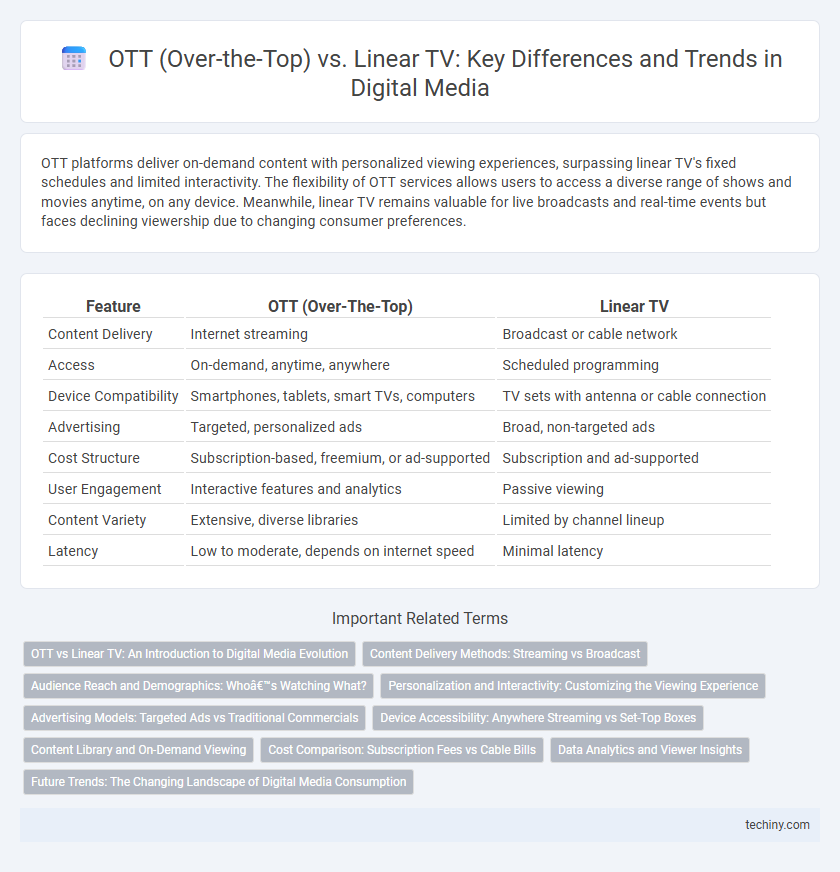OTT platforms deliver on-demand content with personalized viewing experiences, surpassing linear TV's fixed schedules and limited interactivity. The flexibility of OTT services allows users to access a diverse range of shows and movies anytime, on any device. Meanwhile, linear TV remains valuable for live broadcasts and real-time events but faces declining viewership due to changing consumer preferences.
Table of Comparison
| Feature | OTT (Over-The-Top) | Linear TV |
|---|---|---|
| Content Delivery | Internet streaming | Broadcast or cable network |
| Access | On-demand, anytime, anywhere | Scheduled programming |
| Device Compatibility | Smartphones, tablets, smart TVs, computers | TV sets with antenna or cable connection |
| Advertising | Targeted, personalized ads | Broad, non-targeted ads |
| Cost Structure | Subscription-based, freemium, or ad-supported | Subscription and ad-supported |
| User Engagement | Interactive features and analytics | Passive viewing |
| Content Variety | Extensive, diverse libraries | Limited by channel lineup |
| Latency | Low to moderate, depends on internet speed | Minimal latency |
OTT vs Linear TV: An Introduction to Digital Media Evolution
OTT platforms deliver content via the internet, offering on-demand access and personalized viewing experiences that contrast with the scheduled programming of linear TV. This shift has led to increased consumer control, driving significant growth in subscription-based and ad-supported OTT services worldwide. Media companies are investing heavily in OTT infrastructure to capitalize on changing viewer preferences and declining traditional TV audiences.
Content Delivery Methods: Streaming vs Broadcast
OTT leverages internet streaming technology to deliver on-demand content directly to viewers via apps and web platforms, bypassing traditional cable or satellite providers. Linear TV relies on broadcast transmission using terrestrial, satellite, or cable networks to schedule fixed programming in real time. Streaming enables personalized, anytime access and interactive features, while broadcast delivers consistent, high-reliability signal quality to a broad audience simultaneously.
Audience Reach and Demographics: Who’s Watching What?
OTT platforms attract younger, tech-savvy audiences with on-demand access, offering personalized viewing experiences that cater to Millennials and Gen Z demographics. Linear TV maintains strong footholds among older viewers, particularly those aged 50 and above, who prefer scheduled programming and traditional content formats. Audience reach for OTT is rapidly expanding due to increased internet penetration and mobile device usage, while linear TV continues to dominate in markets with limited broadband infrastructure.
Personalization and Interactivity: Customizing the Viewing Experience
OTT platforms leverage advanced algorithms to deliver hyper-personalized content recommendations based on user behavior and preferences, enhancing viewer engagement. Interactive features such as real-time polls, clickable overlays, and choose-your-own-adventure narratives allow OTT users to actively shape their viewing experience. In contrast, linear TV offers limited personalization and minimal interactivity, relying primarily on scheduled programming with a one-size-fits-all approach.
Advertising Models: Targeted Ads vs Traditional Commercials
OTT platforms leverage advanced data analytics to deliver targeted ads based on viewer demographics, behavior, and preferences, significantly increasing ad relevance and engagement rates. Linear TV relies on traditional commercial breaks that broadcast uniform advertisements to a broad audience, resulting in less precise targeting and often higher ad waste. Advertisers benefit from OTT's programmatic capabilities, enabling real-time ad optimization and improved ROI compared to the one-size-fits-all approach of linear TV.
Device Accessibility: Anywhere Streaming vs Set-Top Boxes
OTT platforms offer seamless streaming on multiple devices such as smartphones, tablets, smart TVs, and desktops, enabling users to watch content anywhere with an internet connection. Linear TV relies on set-top boxes tied to physical locations, limiting accessibility to specific televisions and fixed setups. As consumer demand shifts towards flexible, on-the-go viewing experiences, OTT's device accessibility significantly outpaces the traditional constraints of linear TV.
Content Library and On-Demand Viewing
OTT platforms offer expansive content libraries with thousands of titles available for instant streaming, enabling personalized on-demand viewing experiences tailored to individual preferences. Unlike traditional linear TV schedules, OTT services provide flexible access to movies, series, and exclusive content anytime, anywhere, enhancing viewer control over consumption. This shift accelerates consumer migration towards OTT as the preferred digital media format for diverse and convenient content access.
Cost Comparison: Subscription Fees vs Cable Bills
OTT platforms typically offer subscription fees ranging from $5 to $20 per month, providing access to diverse content libraries without long-term contracts or equipment rentals. Traditional linear TV cable bills average $70 to $100 monthly, often including hidden fees for equipment rental, installation, and channel packages. Cost analysis reveals OTT as a more budget-friendly and flexible alternative to conventional cable services, especially for cord-cutters seeking personalized viewing experiences.
Data Analytics and Viewer Insights
OTT platforms leverage advanced data analytics to capture granular viewer insights, enabling precise content personalization and targeted advertising. In contrast, linear TV relies on broader demographic data, limiting real-time responsiveness and audience segmentation. Enhanced analytics in OTT drive superior user engagement and optimize content strategies by monitoring viewer behavior across multiple devices.
Future Trends: The Changing Landscape of Digital Media Consumption
OTT platforms are reshaping digital media consumption by offering personalized, on-demand content that surpasses traditional linear TV schedules, driving a significant shift in audience preferences. Advanced data analytics and AI-driven recommendations enhance user engagement on OTT services, while linear TV continues to cater to live events and appointment viewing. Emerging trends indicate a convergence of interactive features and hybrid models, signaling a future where seamless integration of OTT and linear experiences dominates the media landscape.
OTT (over-the-top) vs linear TV Infographic

 techiny.com
techiny.com